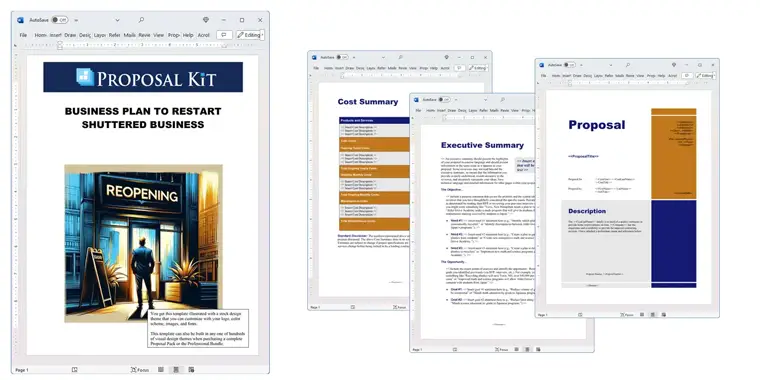How to write your Business Plan to Restart Shuttered Business
We include this 36 page layout with every Proposal Pack. If you want this template to have a different visual design theme than the one illustrated here, purchase any Proposal Pack design and create this template using the purchased design theme. This template is included in every Proposal Pack. If you get a Proposal Pack or the Professional, you can also make any variation of this template with different chapters to suit your needs.
We typically include more chapters in the templates than most people will need to give everyone more variety in the chapters they may need. You can trim down a long template by removing pages you do not need or combining multiple chapter topics into one page.
 DOWNLOADABLE, ONE-TIME COST, NO SUBSCRIPTION FEES
DOWNLOADABLE, ONE-TIME COST, NO SUBSCRIPTION FEESYou can also create countless variations of this document to suit your needs using the included library of 2200+ chapters if ordering a Proposal Pack or Professional.
 What Our Clients Say
What Our Clients SayI am a contractor for the United Way and this product makes the process of writing proposals much easier. I have to work with the Community Financial Stability Committee and we submit at least six proposals per year."
Small Business Risk Analyst
Related Article
Related Video
Related Templates
- Business Continuity Services Proposal
- Succession Planning Proposal
- IT Disaster Recovery Services Proposal
- Disaster Preparation and Training Proposal
- Business Continuity During Labor Shortages Proposal Template
- Web Hosting Business Plan
- Bakery Business Startup Proposal Template
- Labor Cost Management Proposal Template
- Community Impact Mitigation Proposal Template
- Corporate Restructuring Proposal
- Business Model Change Planning Rolling Shutdowns Proposal
- Business Plan
- Retail Location Business Plan
- Technology Business Plan
- Business Plan Funding Request Proposal
- Workforce Efficiency Proposal Template
- Failing Business Turnaround Proposal
- Bank Loan Proposal Template
- Business Funding Proposal Template
- Restaurant and Bar Funding Proposal
- Financial Funding Proposal Template
Reviving Your Business: The Proposal Kit Path to Restarting Operations
In the wake of the economic crisis, many businesses face the task of restarting operations. This challenge requires a strategic approach, especially when it comes to drafting a business plan. But how does one write a business plan when restarting a shuttered business? This is where Proposal Kit steps in.
Imagine facing the challenge of rebooting your business. Could Proposal Kit be the solution you need to put together your restart plan?
The Best Way to Write a Business Plan with Proposal Kit
For those unfamiliar with writing business proposals, the Proposal Kit software and template library is a tool of choice. It simplifies the process, guiding users step by step to create a comprehensive business plan. Notably, the software incorporates a line item quoting database system, essential for writing detailed cost summaries, quotes, estimates, budgets, and other financial elements.
What Types of Projects Are Business Plan to Restart Shuttered Business Written For?
Business plans for restarting a shutter business created with Proposal Kit can cover a range of projects, such as:
- Reopening retail stores.
- Restoring restaurant operations.
- Resuming construction projects.
- Restarting paused manufacturing lines.
- Reestablishing logistics and supply chains.
- Reviving shelved research and development projects.
- Reinitiating services in the hospitality industry.
- Resuming educational programs or institutions.
- Restarting healthcare services.
- Reviving non-profit initiatives.
Chapters this template is built with
Each of these components plays a crucial role in your business restart plan, helping to paint a comprehensive picture for investors, lenders, and other stakeholders of how you intend to navigate the post-crisis landscape and drive your business towards future success.
Executive Summary
This section should succinctly summarize the main objectives and strategies for restarting your business. It needs to clearly convey your vision, the steps you'll take to reopen, and the goals you aim to achieve.
Future Proofing
Develop strategies to make your business more resilient to future crises. This could involve diversifying supply chains, implementing flexible work arrangements, or investing in digital transformation to mitigate risks from potential disruptions.
Replenishment
Detail your plan for restocking necessary materials and equipment. This should include timelines for reordering supplies, renegotiating terms with suppliers, and updating inventory management systems.
Staffing
Describe your strategy for bringing back employees or hiring new staff. This may include training programs to update skills, revised job descriptions to adapt to new operational models, and strategies to maintain staff well-being.
Industry Trends
Analyze how your industry has changed since the crisis. Identify new consumer behaviors, emerging market needs, or shifts in regulatory environments that could impact your business.
Competitive Analysis
Assess how your competitors have adapted post-crisis. Understand their strengths and weaknesses in the new context to better position your business for competitive advantage.
Sales Plan
Develop strategies to revive sales, which might include new sales channels, revised pricing strategies, or targeted promotions to reengage with your customer base.
Marketing Plan
Outline how you will reconnect with your market. This could involve updating your branding, leveraging digital marketing tools, or creating campaigns that resonate with post-crisis consumer sentiments.
Risk Analysis
Identify potential risks associated with restarting your business, such as supply chain disruptions, fluctuating market demand, or health and safety concerns, and propose mitigation strategies.
Income Projection
Provide a realistic forecast of your expected revenue streams. This should consider both the immediate impact of reopening and the longer-term financial outlook.
Breakeven Analysis
Calculate the point at which your business will start making a profit again. This will help in setting realistic financial goals and managing cash flow effectively.
Balance Sheet
Prepare a current balance sheet to provide a snapshot of your business's financial health at the point of restarting, including assets, liabilities, and equity.
Profit and Loss Statement
Project your expected revenues and expenses. This will be critical in tracking your business's financial performance over time.
Budget
Create a comprehensive budget that aligns with your restart plan. This should include operational costs, marketing expenses, staff salaries, and any other costs associated with reopening.
Sources of Funds
Identify where your funding will come from, whether it's personal savings, loans, investor capital, or government grants.
Uses of Funds
Clearly delineate how you plan to use the funds. This should correlate with your overall restart strategy and include specific allocations for different areas of your business.
Repayment Plan
If you are taking on debt, outline a clear plan for how and when you will repay it. This will be crucial for maintaining financial stability and building trust with lenders.
Company History
Reflect on your business's journey before the shutdown, including past successes and challenges. This can provide valuable insights and lessons for the restart phase.
Company Operations
Explain any changes in your business operations post-restart. This may include new processes, technologies, or operational models that you have adopted.
Partnerships
Discuss how existing or new partnerships will play a role in your restart strategy. Partnerships can provide essential support, resources, or market access.
Officers and Board
Detail the roles and responsibilities of key leaders in your business. This section should demonstrate strong governance and leadership, which is vital for stakeholder confidence.
Future Developments
Outline your long-term plans for growth and development. This should include strategic goals, potential market expansions, and plans for product or service diversification.
Use cases for this template
Emily - Delightful Bites Catering
Emily's Delightful Bites Catering, known for its exquisite culinary offerings and impeccable service, faced new challenges in the post-crisis landscape. Recognizing the need to adapt, Emily turned to Proposal Kit to articulate her vision for expansion. She meticulously wrote a plan that not only adhered to the heightened health and safety standards but also introduced innovative menu options designed to appeal to health-conscious customers and those looking for unique culinary experiences.
Using the Proposal Kit's financial tools, Emily detailed the investments needed for kitchen upgrades, staff training in new health protocols, and marketing initiatives to promote her revamped services. Her financial projections demonstrated how these investments would lead to increased customer base and revenue growth.
The comprehensive nature of her business plan, enhanced by the clarity and precision offered by Proposal Kit, played a critical role in securing the confidence of her investors. This funding enabled Emily to successfully implement her new strategies, resulting in a notable increase in bookings and a broader customer base, solidifying Delightful Bites Catering's place in the competitive catering market.
Jordan - Innovative Tech Solutions
Jordan's project at Innovative Tech Solutions was a high-stakes venture - a cutting-edge technology that had been shelved due to prior funding constraints. With the company now ready to revisit the project, Jordan was under pressure to deliver a compelling business plan.
Leveraging the structured approach of Proposal Kit, Jordan was able to quickly assemble a plan that clearly communicated the project's objectives, the innovative aspects of the technology, and its potential to disrupt the market. He included detailed market analysis, showcasing the demand for the technology, and outlined a clear path to market entry.
His financial section, created using Proposal Kit's tools, included a detailed budget, projected cash flows, and a return on investment analysis. This thorough financial planning demonstrated the project's financial viability and potential for high returns.
Presenting his plan to the company's board, Jordan's well-written proposal, backed by solid data and clear financial projections, won the approval and the funding needed to restart the project. This success marked a significant step forward for both Jordan's career and Innovative Tech Solutions' position in the technology sector.
Lucas - Global Aid Network
Lucas, at Global Aid Network, was tasked with a mission-critical challenge: to resume the organization's international aid programs which had been halted due to the crisis. The programs were vital in providing essential services and support to vulnerable communities around the world.
Using Proposal Kit, Lucas meticulously outlined a comprehensive plan to restart operations. He focused on new operational strategies, integrating innovative approaches to delivering aid more efficiently while ensuring the safety of both the aid workers and the recipients. This included the adoption of new technologies for remote monitoring and coordination, and revised protocols to ensure health and safety in the field.
Lucas's plan also detailed the financial aspects, using Proposal Kit's tools to create a budget that accounted for new operational costs and potential funding sources. His presentation of a clear, actionable, and financially viable plan was crucial in convincing donors and stakeholders to reinvest in their programs.
Thanks to Lucas's efforts and the effectiveness of Proposal Kit, the Global Aid Network not only restarted its vital international aid programs but did so with improved methods and strategies, ultimately increasing their impact and reach in the communities they served.
Conclusions and Recommendations
For Emily, Jordan, and Lucas, Proposal Kit was more than just a tool; it was a roadmap to successfully restarting their operations. It provided a structured approach to addressing the complex challenges of reviving a business in the post-crisis world. Whether it's expanding a catering business, reviving a tech project, or restarting non-profit operations, Proposal Kit offers the templates, guidance, and financial tools needed to create a comprehensive and effective restart plan. By showcasing these real-world applications, this article aims to demonstrate how Proposal Kit can be an invaluable asset for anyone needing to write a business plan to restart a shuttered business, ensuring their proposals are not just seen but succeed.
Also Known As
This template may also be referred to in different ways or be used in more specialized situations, such as:
- Revival Strategy for a Previously Closed Business
- Business Reopening and Revitalization Plan
- Strategy Plan for Relaunching a Shuttered Enterprise
- Blueprint for Reactivating a Closed Business
- Business Restoration and Growth Strategy
- Operational Restart Plan for a Dormant Business
- Business Comeback Strategy Proposal
- Plan for Rebooting a Closed Business
- Strategic Roadmap for Business Re-engagement
- Proposal for Re-establishing a Previously Closed Company
Abstract
 Reviving a closed business requires careful planning and an approach, particularly when writing a comprehensive restart plan. Many small business owners find themselves navigating through numerous challenges, such as understanding employment and labor laws, resolving financial obligations, and reassessing their target market. Proposal Kit offers a solution for business owners needing to develop a solid business plan, providing structured templates and financial tools to guide them through the process. This tool assists owners in creating a proposal that addresses the complex realities of reopening a business, from analyzing industry trends to projecting revenue and managing risks.
Reviving a closed business requires careful planning and an approach, particularly when writing a comprehensive restart plan. Many small business owners find themselves navigating through numerous challenges, such as understanding employment and labor laws, resolving financial obligations, and reassessing their target market. Proposal Kit offers a solution for business owners needing to develop a solid business plan, providing structured templates and financial tools to guide them through the process. This tool assists owners in creating a proposal that addresses the complex realities of reopening a business, from analyzing industry trends to projecting revenue and managing risks.
Using Proposal Kit, businesses can start by determining their new business model, incorporating lessons learned from past flops and mistakes. They need to focus on resolving financial obligations, which might involve negotiating with creditors or filing dissolution documents for past debts. An entrepreneur must evaluate their current market position, assess competing products, and leverage testimonials to build credibility. It's crucial to keep messaging clear and communicate with stakeholders about changes in business operations, partnerships, and leadership roles.
Small business owners must also navigate labor laws and employment regulations as they bring back employees or hire new staff. They should prepare for the first year of operations by creating a detailed budget that includes sales tax, operational costs, and marketing expenses. A successful restart plan will outline an exit strategy, taking into account factors like continued taxes and payments to creditors.
 Entrepreneurs should consult professionals, like accountants and lawyers, to ensure compliance with laws and to handle complex financial topics. Additionally, they must learn from their own flaws and past failures, understanding that a positive mindset and entrepreneurial spirit are crucial for success. By addressing pain points and using past experiences, business owners can develop a plan that not only meets high expectations but also positions their company for future growth and stability.
Entrepreneurs should consult professionals, like accountants and lawyers, to ensure compliance with laws and to handle complex financial topics. Additionally, they must learn from their own flaws and past failures, understanding that a positive mindset and entrepreneurial spirit are crucial for success. By addressing pain points and using past experiences, business owners can develop a plan that not only meets high expectations but also positions their company for future growth and stability.
Ultimately, the Proposal Kit is more than just a tool; it's a roadmap to success in the demanding journey of restarting operations, ensuring businesses can overcome previous challenges and thrive in a competitive landscape.
Reviving a business that has weathered a shutdown demands not only a robust plan but also keen insight into the dynamics of market conditions and consumer behaviors. Many business owners, especially sole proprietors, find themselves at a crossroads, needing to navigate complex factors like changing labor laws, restructuring financial obligations, and reassessing their target market. Proposal Kit emerges as an invaluable tool for these entrepreneurs, offering structured templates and financial planning resources that simplify the challenging task of creating a comprehensive business plan for restarting operations.
 A critical first step in this journey involves acknowledging past mistakes and learning from them. Business owners must examine their own flaws, identifying red flags from prior failures to avoid repeated missteps. By conducting a thorough competitive analysis, they can understand the strengths and weaknesses of competitors, which informs their strategy for differentiation and market re-entry. This involves using testimonials to bolster reputation and employing innovative marketing strategies that resonate with potential users.
A critical first step in this journey involves acknowledging past mistakes and learning from them. Business owners must examine their own flaws, identifying red flags from prior failures to avoid repeated missteps. By conducting a thorough competitive analysis, they can understand the strengths and weaknesses of competitors, which informs their strategy for differentiation and market re-entry. This involves using testimonials to bolster reputation and employing innovative marketing strategies that resonate with potential users.
Financial planning is at the heart of a successful restart, requiring an entrepreneur to manage payments, debts, and financial obligations. Proposal Kit aids in preparing detailed financial documents such as projected revenue forecasts, breakeven analyses, and balance sheets, thus ensuring transparency and accountability. Business owners must also determine sources of funds, whether through investor capital, loans, or personal savings and outline a clear repayment plan to build trust with creditors and investors.
Addressing labor and employment considerations is equally crucial. Business owners are urged to consult with accountants and attorneys to ensure compliance with employment and labor laws, minimizing the risk of legal setbacks. This process involves updating job descriptions, conducting training programs, and maintaining employee well-being to foster a motivated workforce ready to meet the demands of the new business landscape.
 In addition to operational adjustments, companies must focus on risk management by conducting a SWOT analysis to identify internal and external threats. By formulating strategies to mitigate these risks, businesses can enhance their resilience in the face of future challenges. Regular progress evaluations and adapting to market feedback are vital in staying aligned with the needs of the target market.
In addition to operational adjustments, companies must focus on risk management by conducting a SWOT analysis to identify internal and external threats. By formulating strategies to mitigate these risks, businesses can enhance their resilience in the face of future challenges. Regular progress evaluations and adapting to market feedback are vital in staying aligned with the needs of the target market.
Moreover, the Proposal Kit facilitates the creation of a marketing plan that emphasizes brand differentiation and clear messaging. Engaging with stakeholders through effective communication builds confidence and aligns everyone with the shared vision for the business's future. Additionally, exploring new partnerships and collaborations can provide valuable support and resources critical for the business's successful revival.
The Proposal Kit serves as a guide in navigating the complexities of restarting a business and helping entrepreneurs turn potential setbacks into opportunities. By addressing the multifaceted challenges of revival with a clear, actionable plan, business owners can achieve a successful comeback and secure a sustainable future in the competitive market.
Frequently Asked Questions
What should be included in a restart business plan?
A restart business plan should include a comprehensive market analysis that reassesses the current market conditions and identifies new opportunities or shifts in consumer behavior. Detail your revised business model, clearly outlining operational changes, product or service modifications, and the latest marketing strategies. Including a robust financial section with updated forecasts, break-even analysis, and funding requirements is critical. Also, document any changes in management or structure that will support the business's new direction. This plan should conclude with a realistic timeline for reopening and achieving milestones.
How do I address financial needs in a restart plan?
Clearly articulate the financial needs by detailing startup costs, operational expenses, and anticipated cash flow issues. Explain how funds will be allocated and identify specific sources of capital, whether through loans, investor funding, or personal investment. Include a contingency plan to manage unexpected expenses or revenue shortfalls. Financial projections should be conservative, reflecting the risks and potential delays in achieving profitability.
What strategies can help mitigate risks in restarting a business?
To mitigate risks, conduct a SWOT analysis (Strengths, Weaknesses, Opportunities, Threats) to better understand internal capabilities and external market conditions. Develop strategies to leverage strengths and opportunities while addressing weaknesses and threats. Incorporate flexibility into the operational plan to quickly adapt to market changes or challenges. Risk management should also include legal and financial safeguards to protect the business.
How do I reassess the market and competition after a shutdown?
Start by conducting new market research to gather current data on consumer trends, market demand, and economic conditions. Analyze competitors who have survived or emerged in the market during your shutdown. This assessment should inform how you position your business, differentiate from competitors, and meet your target audience's evolved needs and preferences. Use this information to adjust your product offerings, pricing strategies, and marketing campaigns.
What follow-up actions are essential after reopening the business?
After reopening, closely monitor business performance against the plan's benchmarks and adjust strategies as necessary. Regularly update your financial projections based on actual performance. Engage with customers through feedback loops to refine products and services. Continuously scout for new market opportunities and threats. Maintaining transparent communication with stakeholders, including investors, employees, and customers, is vital to build confidence in the business's stability and growth prospects.
20% Off Discount
![]() Add To Cart This Word Template
Add To Cart This Word Template
 Add To Cart Proposal Pack for Any Business
Add To Cart Proposal Pack for Any Business
 Add To Cart Proposal Kit Professional
Add To Cart Proposal Kit Professional
 4.7 stars, based on 849 reviews
4.7 stars, based on 849 reviewsProposal Kit chapters used in this template
Cover Letter (Business Plan), Title Page, Table of Contents, Executive Summary, Business Model, Competitive Analysis, Market and Audience, Strategic Planning, Sales Plan, Marketing Plan, Future Developments, Risk Analysis, Risk Management, Future Proofing, Staffing, Inventory, Replenishment, Income Projection, Breakeven Analysis, Balance Sheet, Profit and Loss Statement, Sources of Funds, Uses of Funds, Funding Request, Budget, Repayment Plan, Company History, Services Provided, Products, Company Operations, Assets, Our Clients, Partnerships, Legal Structure, Officers and Board, Back Page
Line Item Automated Chapters
If you purchase a Proposal Pack or the Professional Bundle, these proposal pages are generated using an automated line-item database in the included Wizard software.
Income Projection, Breakeven Analysis, Balance Sheet Three Year, Profit and Loss Statement Three Year, Funding Request, Budget Three Year
You use this proposal for
- Non-technical proposal
- Product sales proposal
- Service sales proposal
- Business plan, loan, investor funding proposal
- Business opportunity, partnership proposal
How to create this template with Proposal Pack Wizard
You can create this document using any of the logo-designed Proposal Packs. Pick any Proposal Pack with a logo design theme you like best; they will all work equally well. The Proposal Pack for Any Business is the pack with no extra added logos or colors - designed to be used plain or for you to customize with your logos and graphics.
The Proposal Pack design theme you purchase will determine the visual look of this template. The screenshot above only shows the plain generic design theme.
We include a library of chapters to be assembled based on your needs. All proposals are different and have different needs and goals. We designed Proposal Pack so you can customize the documents to suit your needs.
You will best create this document using the Proposal Pack Wizard - Expert Edition software to select this template and build it in the Proposal Pack logo design theme of your choice along with any desired customizations (such as adding additional chapters, removing unneeded chapters, changing the order of chapters, and importing your company logo). This template outlines a proposal for the described situation. Each user is responsible for typing in the actual content of the provided pages with their information to complete the proposal. Suggestions in the abstract may include features in higher-end packages and are facilitated by the selection of chapter templates to support the narrative of each proposal, which help guide the user in filling in the details.
The Wizard software's AI Writer will write the content of the pages of the template based on details provided for your company, client, project, financial details and other writing instructions. This will provide a personalized version of the template completely written and ready to edit.
Once finished, the AI Writer's Word-to-PowerPoint converter can transform your proposal, business plan, or other business documents into a PowerPoint slideshow. Save time and effort by letting the AI analyze every chapter to condense its content into talking points, visually matching the document, and providing a consistent package of presentation material with the click of a button.
You create this template using the Wizard software with an entire Proposal Pack library and software. We include the Expert Edition of the software in the Proposal Kit Professional. Microsoft Word for Windows is required to use the customizing software. You can also edit Word document templates in other office software such as Word for Mac. We will assist Mac users in assembling complex templates for their first project if they do not have the required platform to run the Wizard software.
How to Build Templates Featured on Proposal Kit Website
Many people find the Proposal Kit website after searching for a specific proposal. Once you've purchased and installed the software, how do you build that template you found in the first place? This video shows you how to build any proposal you see on the Proposal Kit website.
 Ian Lauder has been helping businesses write their proposals and contracts for two decades. Ian is the owner and founder of Proposal Kit, one of the original sources of business proposal and contract software products started in 1997.
Ian Lauder has been helping businesses write their proposals and contracts for two decades. Ian is the owner and founder of Proposal Kit, one of the original sources of business proposal and contract software products started in 1997.By Ian Lauder
 Published by Proposal Kit, Inc.
Published by Proposal Kit, Inc.


 Cart
Cart
 Get 20% off ordering today:
Get 20% off ordering today: 


 Facebook
Facebook YouTube
YouTube Bluesky
Bluesky Search Site
Search Site